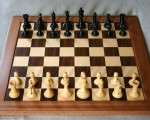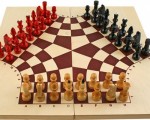Just a little post to show you guys a few pictures. Io9 has a small gallery of Schuiten pictures. It’s part of io9s Future Metro feature this week. And just so you know, Schuiten’s a comic artist famous for producing interesting cityscapes and buildings in his works. Check it out real quick.
The three Qualities of Level Design
In this post I’ll talk a bit about the goals and requirements of good level design. This thing has grown out of my architecture degree and the numerous lectures I held on the subject of level design – especially those with architects-in-training as their audience. So if you’ve sat in on one of them, this will propably be familiar.
So before I get into level design, I’ll first have to talk a bit about architecture. Thousands of years ago, the roman architect Vitruvius identified what he called the three “qualities of architecture”. They are as follows:
- Firmitas, stability. The building stands stable on it’s own
- Utilitas, usability. The spaces created by the building are suited for their intended use
- Venustas, beauty. This building has a beautiful aesthetic
They do make sense, right? Admittedly categorizing things is often arbitrary and can be argued for or against but I kinda liked that setup, where each layer is building on one another. If your building isn’t standing safely, it doesn’t matter much if your kitches is perfectly laid out. And if your doors are too small for people to get in properly, then it doesn’t help that the aesthetics are wonderful – the building itself is still a failure.
Now I tried transporting this divide over to level design, and this is what I got:
- Firmitas, stability. The level runs well without any technical or performance issues
- Utilitas, usability. The space does a good job at leveraging the game mechanics
- Venustas, beauty. The environment creates an atmosphere and provides affordances.
I’ll elaborate a bit on these three qualities and how I think they relate to level design as a discipline:
Firmitas
As mentioned before, this is a pretty basic category. A sort of minimum requirement if you will. If a level fails to fulfill it, it ceases to be properly playable due to technical issues. The two main areas here are stability and performance.
Stability as I see it refers to the level not crashing and breaking the game. Nowadays it’s usually quite hard to do that with a level itself since most engines are quite robust. It could be doable though with the level referencing a file that doesn’t exist or something similar. Also if there’s some sort of level script then that might be another source of errors. Of course if such a crash is very very rare it might not affect playability too much because it’s really hard to cause it. Still it’s a flaw in the “foundation” of the level. This can be avoided by working cleanly and paying a lot of attention. It might still creep in but that’s what the QA is for…
Performance is the other side and means that the level is running properly. Again this has become a bit less of an issue with higher end systems but it basically just means that your level doesn’t suffer from stuttering and frame-rate drops. In small amounts this can still be bearable but if your multiplayer level slows down to a crawl because there’s 6 players and 2 explosions, then you’ve done something wrong. This is often at odds with the graphics of a environment – the more detail you have the more your performance will drop. In the end it comes down to a balance between the two. And of course there’s a lot of clever tricks and thught out optimization involved. Everything from detail brushes to visportals and distance fog/culling. Whatever will do the trick.
Utilitas
This aspect of level design deals with the design of the actual play space. That is to say it defines the space within the player moves. I’ve talked (or at least tried to) about my definition of the digital play space some in my last (somewhat controversial) rant about how level design is game design. I’m afraid I failed somewhat since there were a lot of misunderstandings there – but I’ll try again sometime, maybe visually. Alright, slightly off course here, Let’s get back on track.
Utilitas defines the boundaries within which the player(s) move(s). It directs the flow of play and it’s job is to iteract closely with the game design to provide the intended experience (which doesn’t neccessarily have to be “fun”). It’s worth to note that these spatial constraints are what make the game possible and if they are changed, the possible experience is too.
The details of what Utilitas actually entails are too many to mention. This surely would be a great project quite similar to the 400 Project from Noah Falstein and co. but goes beyond the scope of this article, especially as these are highly dependent on the genre and game design involved.
These goals can range from anywhere between controlling the flow of players within the space to providing obstacles and challenges for the player to overcome.
Venustas
The words original meaning and the quality as it relates to architecture refers to beauty. That is to say that buildings are supposed to be pleasant to look at. This makes a lot of sense if you consider the fact that buildings are quite permanent construct and having a disgusting building in the middle of town could be considered visual terrorism for some sensible eyes. Of course back then Vitruv didn’t know or write about theme parks and other types of experiential architecture. There being “ugly” can sometimes be goal.
And the same’s true for levels. They don’t need to be beautiful, instead their goal is to evoke a mood, an atmosphere. So following that tenet, everything that relates to the creation of mood and visual references is part of this category.
Admittedly there’s some overlap with Utilitas since the visuals affect usuability. For example when putting moody lighting in a scene the designer needs to take care that the important areas are still visible. Or when trying to use visuals to steer the player. That said, for the sake of easier categorization it’s safe to put everything that doesn’t affect the space (textures, light etc.) directly into this category.
Besides mood and atmosphere, there’s a few other jobs that the audiovisuals of a level can do. A quite important (and easily overlooked) one is that they can create associations. Familar visuals can cause certaun expectations in the player and they establish a frame of reference. If there’s a castle on a hill, odds are that there are going to be guards and that there’s something worth guarding there. Expecting some sort of ruling body there wouldn’t be too far fetched either. Of if there’s a door it might suggest that it can be opened. All of this are helpful cues to help the player figure out what he can do.
Additionally the audiovisual elements can help tell a story. Both in the larger sense of selling the setting (castles for traditional fantasy, spaceports for science fiction) and in smaller instances of telling small stories within the world. The entire topic of spatial storytelling is actually a fascinating one that I plan to write another article on in the near future.
So that’s it. That’s my rundown of the three Qualities. Now what do you guys think? Is that a sensible system to categorize and analyze by?
New Job: Gameforge
Starting today I’m emplyed again. This time as a Game Designer for Gameforge. A German development studio cum publishing house focusing on development of browser games and the publishing of free-to-play MMORPGs.
Let’s see what I’ll get to do and how it goes.
Procedural Cities on the BLDGBLOG
An interesting article over at the BLDGBLOG about procedural generation of cities. That’s a topic I’m really interested in and that article is a good quick read with some interesting links to further stories.
Especially noteworthy are the game Subversion from Introversion and the procedural city project from Shamus Young of DM of the Rings webcomic fame. Also Viktor Antonov, designer of City 17 is mentioned in there. If you remember, I’ve already stumbled over him in the EDGE podcast I linked to a few days back.
Check it out.
Also if anyone has some additional info on Marco Corbettas Structure, I’d love if you could share…
EDIT: Here’s a YouTube video on Structure.
Level Design is Game Design
Level Design is Game Design!
Have I got your attention? Alright, so I admit the two are not perfectly the same but I am convinced that Level Design is nothing but a specialized application of Game Design. And I can prove it! First let’s start by looking at a pretty okay definition of Level Design:
Level Design is the process of designing and implementing the digital spaces of a video game
Sounds simple enough, right? Of course if we were scientific about this we’d have to take a closer look at what digital spaces are. However that’s beyond the scope of this article and will be something I’ll talk about another time. For now let’s look at board games. Why? Because they’re quite similar to video games and because it makes it a lot easier to understand the topic.
 Now with board games, you have the rules of the game, which encompass how pieces can move, how a turn plays out and what the victory conditions are. The other half of that puzzle is the design of the actual board, which could be seen as the level design of the game. It’s evident that when the board is changed, the entire game changes with it. Imagine a game of chess, where the board is not 8×8 fields but instead 8×12 or maybe something more outlandish like an L shape. This will drastically change how the game is played. The same is true when a level is changed.
Now with board games, you have the rules of the game, which encompass how pieces can move, how a turn plays out and what the victory conditions are. The other half of that puzzle is the design of the actual board, which could be seen as the level design of the game. It’s evident that when the board is changed, the entire game changes with it. Imagine a game of chess, where the board is not 8×8 fields but instead 8×12 or maybe something more outlandish like an L shape. This will drastically change how the game is played. The same is true when a level is changed.
 So if you think about it, the game space is nothing but another set of rules. They’re just visualized as a space to make it easier for us. Instead of rolling a die and tracking the movement pieces on a board, we could simply use numbers to denote a token’s position. Say if you’re on field “3” and roll a 5, you wouldn’t move your piece 5 spaces, you’d write down “8” instead. And then if there’s “special fields” you’d have a table where you could look up the number and see if there are any special rules for it. It’s obvious that this is a lot more complicated than moving a piece on the board, which is why we use spaces for a lot of our board games.
So if you think about it, the game space is nothing but another set of rules. They’re just visualized as a space to make it easier for us. Instead of rolling a die and tracking the movement pieces on a board, we could simply use numbers to denote a token’s position. Say if you’re on field “3” and roll a 5, you wouldn’t move your piece 5 spaces, you’d write down “8” instead. And then if there’s “special fields” you’d have a table where you could look up the number and see if there are any special rules for it. It’s obvious that this is a lot more complicated than moving a piece on the board, which is why we use spaces for a lot of our board games.
So if game spaces are just rules why is there a split between game and level design? There is no such thing in board game design, right? Well the answer’s simple: In the early days of game development there was no seperation: there often was just one person making the entire game, designing the rules, the spaces, the graphics and the sounds. But Because the increasing amount of content and complexity required specialization we now have different people doing different parts of the same job.
So with all that said, let’s look at that definition again:
Level Design is the process of designing and implementing the (spatial) rules of a video game
And let’s look at Wikipedia’s definition of Game Design
Game Design is the process of designing the content and rules of a game
Sounds awfully similar, doesn’t it? There’s just a few differences:
- Level Design only deals with those game rules which are manifested as spaces
- Level Design is also responsible for the implementation of these rules in the game
- Level Design only really exists as a discipline in the realm of video games
I rest my case.
No More Wrong Turns is online
 The article I’ve been mentioning and working on in the past couple of weeks is finally online. You can read No More Wrong Turns over at Gamasutra. It deals with ways that Game and Level Designers can steer the movement of players.
The article I’ve been mentioning and working on in the past couple of weeks is finally online. You can read No More Wrong Turns over at Gamasutra. It deals with ways that Game and Level Designers can steer the movement of players.
Give it a read and please let me know what you think. I’m eager to get some feedback. Feel free to post a comment over at Gamasutra or here on my blog.
Edge Panel on Architecture and Videogames
I just stumbled over this feature from Edge magazine called Architecture and Videogames. It’s a recording of a panel on – who would have guessed – Games and Architecture. It’s avilable as an mp3 on the link above and it’s really interesting. I’ve found inspiration to get back to two blog articles I’ve already started. Be warned though, the recording is quite long.
The panel is made up out of a mix of people who have a background in both architecture and video game development. They do make a lot of interesting points on what digital game architecture is and how it relates to physical architecture. I particularly liked the comments about the design of experiences, something that’s firmly in the realm of level design. It’s the job of a level to provide an entertaining joyride with highs and lows. On the other hand there’s few architectural spaces that are designed to provide experiences. The few exceptions that do are things like theme parks or monumental architecture.


